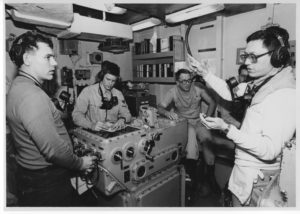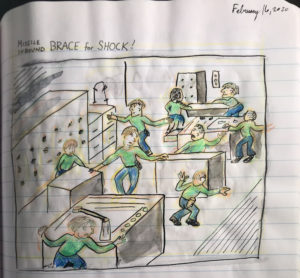We were a couple of miles off the coast of Kuwait, operating in a “box” about ten miles long by half a mile wide. Several days before, two naval ships, the USS Tripoli and the USS Princeton had struck mines in these waters. Our operations area had been swept and declared clear of mines, but we were still moving at a fairly slow speed and in tight quarters. It takes most of that available half mile just to turn a battleship around.
We had been conducting naval gunfire support (shore bombardment) for some time with the sixteens striking various targets inland, such as tanks, munitions dumps, etc. The men and equipment you see in the photo were responsible for aiming and firing the sixteen-inch guns from this compartment, the forward main battery plotting room. Suddenly the captain’s frantic voice blared out of the 1MC, “missile inbound, all hands brace for shock!” So we stopped what we were doing and everyone thought, “oh no, we might die.” Then we bent our knees, stood on the balls of our feet, and braced ourselves against whatever solid thing we could find while we waited to see what would happen.
I thought about our friends who were topside in the fire control directors. Not long before, I had been assigned to one of the directors and knew that if we were struck, those men who were assigned outside of the safety of the armored belt that protected engines and fire control equipment would be in the most danger. Those men later reported that they could see the missile streaking towards us across the sky.
There were two Silkworm missiles fired at us that evening; the first one fell harmlessly into the ocean completely missing us and the second heading right at us was shot down by the HMS Gloucester in what turned out to be the first successful missile to missile combat engagement in naval history. The only actual damage we received was some friendly fire from another escort ship (I will have to look up what ship that was) but there were no injuries.
The friendly fire incident was also historic. It might have been the first time a military autonomous robot fired at and struck a friendly unit in combat. The neighboring ship (USS Jarrett?) had put the Phalanx CIWS into “full auto” mode, meaning it would detect and engage all threats without human intervention. When the USS Missouri saw the missile heading its way, the electronic warfare men activated anti-missile countermeasures. One of these, our SRBOC chaff launcher, fired a canister of chaff that was meant to distract the missile away from us, but it inadvertently also got the attention of the full-auto CIWS on the other ship. The CIWS automatically opened fire with its 2,000 round per minute depleted uranium Gatling gun and hit the Missouri a few times by accident.
In the end, we survived unscathed and were thankful to be alive.

